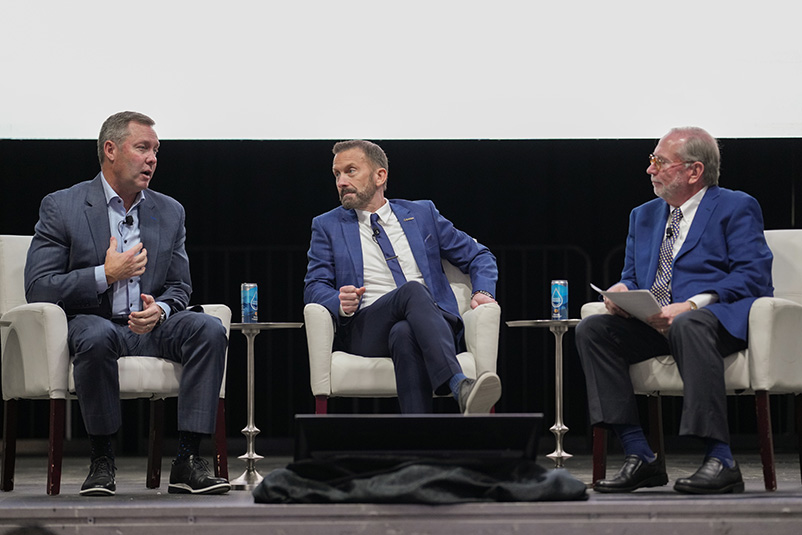
USGA CEO Mike Whan, GCSAA CEO Rhett Evans and Golf Digest chairman and and editor-in-chief Jerry Tarde discussed the future of the golf industry on the GCSAA TV stage at the GCSAA Trade Show. Photo by GCSAA
The bad news about golf, according to Jerry Tarde, Golf Digest chairman and editor-in-chief: “Pro golf is broken and it's unclear whether it can be repaired. That's how disruption works, and it lingers a long time.”
Fortunately, recreational golf is stronger than it’s ever been. “The sport you and I play, serviced by GCSAA and the USGA, is the greatest game in the history of the world, and today it's vibrant."
Tarde was the moderator for a session titled “Working Together for Golf’s Future: Insights from USGA and GCSAA Leadership,” which also featured GCSAA CEO Rhett Evans and USGA CEO Mike Whan. Together, Evans, Whan and Tarde discussed the future of the industry from the GCSAA TV Stage on the trade show floor of the 2025 GCSAA Conference and Trade Show in San Diego. Two issues of particular interest: how to keep golf sustainable, and how to keep attracting and retaining the increasingly diverse audience that’s driving the growth of the sport.
“Diversity may be under fire in Washington, but it’s an economic necessity in golf,” Tarde said in his opening remarks. “We need it for labor, and we need it for the game to grow.”
Whan agreed, saying the USGA’s customer base has changed drastically in the last few years.
"Ten years ago, if you told anyone this game was going to grow by 50%, we wouldn't have believed it. If I said that growth was coming from juniors, women and people of color, you'd have thought I was smoking something," Whan said. "Our customers look different than from even five years ago."
Another issue at the top of Whan, Evans and Tarde’s minds is sustainability — both in the environmental sense and in keeping golf accessible to the people who may next generation of athletic and industry leaders. For Whan, that means the USGA listens and adapts to the needs of golf course superintendents, understanding that different locations and require different solutions.
“Change is hard, but we’ll get there. It’s a process,” Whan said. “(with the USGA) You’ll get a partner who can not only tell you how to do it but has experience doing it in the marketplace. We’re investing in the future.”
Evans agreed that long-term survival for the industry requires collaboration, with each participant lending their mutual skills toward a common goal. That common goal, for Evans, is simple.
"At the end of the day, you've got to create playing surfaces that 20 million players can enjoy," Evans said. "The people at this show have to figure out how to make that work, and balance the amount of play with increased expectations, and how to use innovations that make their jobs not just easier, but more effective."
Maintaining those standards, and the future of golf, requires partnership, Evans said, and GCSAA’s partnership with the USGA is a prime example.
“There are strengths and relationships that you have as an organization that we don’t, and some of what we have you don’t. We pieced together our knowledge and we’re stronger for it,” Evans said. “The importance of this collaboration is to stay in our lane, but let’s all be going the same direction.
Abby Olcese is GCM’s online editor